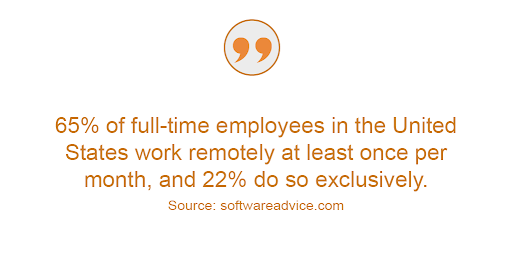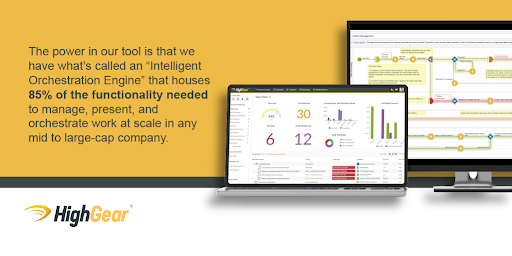
Our world is changing fast, and so too is the way we work. With more remote workers and competitive pressures than ever, the digital landscape is constantly evolving and your enterprise must be able to adapt to rapid – and oftentimes critical – transformation. Staying competitive and being able to continuously introduce innovative solutions to the marketplace depends on this flexibility, but the larger the organization the more difficult this can be.
Why is This More Difficult for the Enterprise?
The challenge for mid to large-cap companies is that the execution of work involves many more stakeholders, coordination across distributed teams, and more complex structures that collectively introduce multiple friction points along process pathways. Greater complexity increases the opportunity for risk at every step along the way. In regulated industries, this can be increasingly catastrophic and expensive when risks go unchecked or are not effectively mitigated.
During and after the COVID-19 pandemic, more organizations have found themselves operating remotely which has exacerbated the work management and coordination issues that already exist across enterprise teams. What’s more is that many companies found themselves behind in tech deployment and adoption as COVID was picking up steam. Many have not yet recovered and digital transformation has become a significant focal point but without the readiness and in-house capability needed to get ahead of the curve. So, how do businesses in today’s tumultuous climate get to better manage and execute work – across the board?
Is Remote Work Here to Stay?
One significant consideration to getting better business performance is that remote work has become the norm. According to softwareadvice.com, “65% of full-time employees in the United States work remotely at least once per month, and 22% do so exclusively.” Not only do workers desire remote work, but according to remotebliss.com, remote workers are 13% more productive than traditional office workers. However, remote work creates questions about security, introduces collaboration challenges, and for every self-accountable superstar there is another whose accountability is lacking.
The other challenge related to remote work is the kind of oversight, security and data protection that is difficult for even the most secure environments. Home offices have not been designed with the kinds of security protocols that one might need especially for highly regulated industries.
Have you ever thought about your Personally Identifiable Information (PII) being shared or worked on via someone’s home internet service provider? What about corporate financial transactions taking place by key personnel at home with the many distractions that can occur? And who might be in an employee’s kitchen when they walk away from their unsecured or unlocked laptop? While many large companies have found ways to support the new normal of remote work, we have to wonder if business leaders have really had time to consider all the downstream implications of what working from home has introduced.
Record Unemployment and Talent Shortages
While much is changing in our economic landscape today, one thing we know for certain is that developers are and will continue to be in short supply. Couple this with record unemployment rates and one can see a supply and demand crisis in the making. Digital innovation, designed for better work management within a company, is in high demand. But the supply to address it is increasingly tight. It was reported in a CNBC report that the rate of unfilled IT jobs in the U.S. alone stood at nearly 918,000 at the end of 2021.
Better, more digitally focused, ways of serving customers are also in high demand. The increasing technology needs of both the front-office and back-office in an enterprise are causing concern and frustration in IT departments as well amongst business leadership around the world.
The problem is that the mindset with which organizations need to address these problems hasn’t really changed. Most businesses still believe that unless software solutions are built in-house, they are simply not going to be sufficiently tailored nor will they create a competitive advantage. The other concern that many tech leaders have relates to integration and the ongoing use of legacy systems.
The reality is that today’s software and tech platforms take these concerns into account and are starting to eliminate the downside altogether. However, market awareness is still lagging behind. Currently, the average mid-cap or large-cap company is relying on multiple solutions/platforms/applications/software to address every imaginable component of operating a business. According to Zylo, a SaaS Management Platform, there are an average of 609 applications in a larger enterprise’s SaaS platform. And sometimes, they don’t even realize what tools are being used. The bigger challenge is how managers and leaders gain control of what could be a runaway train – one that allows anyone and everyone to approve the use of new software for his/her pet project or for a single team’s needs without consideration of the entire organization.
SaaS to the Rescue?
Given the proliferation of applications, software, and platforms that have come onto the market in recent years, confusion about how to evaluate and buy a solution has been thrown into the mix. Companies are not only worried about their talent and how everyone works in disparate and significantly changing environments, but they are also wrestling with how to address tech demands while keeping control of things like risk and overall business performance.
As a means of cutting costs and keeping organizations current on the tech front, SaaS (Software as a Service) came on the scene around 2001. It didn’t take long for companies to see that moving away from having to buy, maintain and manage internal tech infrastructure could offer significant economic and strategic benefits that are attractive.
Over the last twenty years, SaaS has grown rapidly, transforming the software business model from its infancy to where it is today – powering many of the business functions at even the largest companies. It is estimated that the SaaS market will continue to grow by at least 18% per year for the foreseeable future. It should also be noted that research projected that 99% of organizations would be using one or more SaaS solutions by the end of 2021. SaaS trends include solutions that increase margins, improve the ability to predict revenue, increase customer retention, and make access to customer data much easier to distribute.
The downside of SaaS in today’s environment is that there is an overabundance of solutions and it’s nearly impossible to clearly discern the difference between them – especially if internal company stakeholders don’t have absolute clarity around how to solve their business challenges. And with technology departments being resource-constrained even their knowledge and ability to choose solutions is being thwarted by lack of time and insufficient insights needed to stay on top of new tools and tech approaches. Yet given the myriad of other challenges facing organizations today, “buy” vs. “build” has become a more obvious choice. Reinventing the wheel or going for a fully custom in-house solution is no longer prudent in most cases.
Is There an Alternative?
So, how is it that companies can be successful in buying a number of pre-built solutions, integrating them, and knowing that the outcome will be as good if not better than building something in-house? The answer is two-pronged. First, no-code platforms are on the rise and becoming increasingly more sophisticated by the day. And many have already outpaced highly complex, customized solutions that have been built in-house by enterprise IT departments.
Secondly, users are becoming ever more tech-savvy and know how to wield no-code tools in ways that many business leaders can only imagine. The significant benefit to this is that it’s the users who often know exactly what a business needs to be successful when it comes to process and execution at a micro-level. They, in turn, have a sense of what a tool needs to do. And when that knowledge is aggregated across teams, the solution requirements practically write themselves. The key to addressing the “buy” vs. “build” decision is to have the right stakeholders, and change-friendly users in the room, and this typically means having a cross-functional team in place for tech evaluation and deployment.
Still Not Believing in No-Code?
As the old adage goes “proof is in the pudding”. There’s no doubt that the market is extremely confusing right now especially when it comes to “no-code” and even more so if you are looking for “workflow” capable solutions. And not all no-code solutions are created equal. Pick the wrong one and the organization will likely shy away from the idea that no-code solutions can be profoundly useful and also be the right choice. Once bitten, twice shy holds true.
The misconceptions and pre-conceived notions of the no-code market are not only creating hesitant buyers, they are causing organizations to believe that deploying low-code is far better. It doesn’t help that as consumers, we are likely using some kind of no-code app or tool in our everyday lives, ultimately shaping the way we think about no-code at work. This too can negatively shape perceptions of what is possible with no-code across an enterprise.
But, what we’re hearing in the marketplace is that low-code is creating even more work for technology departments than custom work. How can this be? Well, let’s consider that not only does the IT department need to finitely understand what the business needs, they in turn must learn how to use a low-code tool and how to deploy it. Often a turnkey solution turns out not to be so turn-key over the long haul. In fact, even if low-code solutions make an initial deployment faster, maintaining them can be more work than if they were built from scratch.
So, where does that leave us on the “buy” vs. “build” continuum?
The Beauty of Targeted No-Code Solutions
Discernment in the “buy” vs. “build” equation is essential. Take HighGear for example. Our focus on workflow allows us to be both extraordinarily sophisticated and one of the easiest tools on the market to configure and deploy rapidly. And the power in the tool is that we have what’s called an “Intelligent Orchestration Engine” that houses 85% of the functionality needed to manage, present, and orchestrate work at scale in any mid to large-cap company.
What that means is that users only need to configure a handful of behavioral components in the tool to get a well-tailored solution for their organization. And with the ability to put rules and permissions in place from groups down to the individual user level, security concerns don’t need to be a part of the equation. At the end of the day, there is no avoiding proper due diligence and evaluation of the software and platforms. We just want to make sure the market knows that “no-code” has evolved significantly. It no longer has to mean “no way” when it comes to meeting the extraordinary demands of sophisticated, complex, or even highly regulated industries with a solution like HighGear.
Managing Work at Scale
Beyond the question of “buy vs. build” in enterprise organizations, deploying talent is at the forefront of many business leaders’ minds these days. We’ve already mentioned the state of talent shortages and low unemployment rates around the world. While the latter trend may be shifting, the shortage of capable talent in many departments will likely continue to be felt today and well into the future. Similar to the idea of “buy” vs. “build”, organizations need to consider how to address this. The thought of outsourcing to freelancers and/or large teams of individuals located thousands of miles away from the core of the business is creating consternation.
The good news is that better no-code tools – that support the management of work at scale with fewer and different types of resources – are now available. Also, leaders, managers, and everyday business users are beginning to understand that just like deploying a finance system for invoicing and front office support, work management at scale allows for automation, tracking, auditing, and securing thousands of transactions in the back office and across the enterprise.
Take trailblazers like Hewlett Packard Enterprise, TCEnergy, Move.com, Baillie Gifford, and the U.S. Department of Defense. Most were early adopters of HighGear and have realized significant gains in productivity, business performance, and optimization. While “buy” vs. “build” is a tough decision when it comes to secure, enterprise workflow that scales, large organizations have shown that the benefits and ROI fully support the deployment of a no-code, configurable workflow platform.
Reach out to HighGear to learn more.



